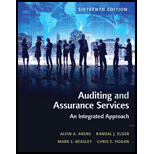
Auditing and Assurance Services, Student Value Edition (16th Edition)
16th Edition
ISBN: 9780134075754
Author: Alvin A. Arens, Randal J. Elder, Mark S. Beasley, Chris E. Hogan
Publisher: PEARSON
expand_more
expand_more
format_list_bulleted
Question
Chapter 15, Problem 23.1MCQ
To determine
Determine the upper precision limit (CUER) in statistical sampling.
Expert Solution & Answer
Want to see the full answer?
Check out a sample textbook solution
Students have asked these similar questions
Everlast Corp. has net working capital of $720, net fixed assets of $3,150, sales of $8,400,
and current liabilities of $1,050. How many dollars worth of sales are generated from every
$1 in total assets?
Give me total assets?
Answer the following requirements for this accounting question
Chapter 15 Solutions
Auditing and Assurance Services, Student Value Edition (16th Edition)
Ch. 15 - Prob. 1RQCh. 15 - Prob. 2RQCh. 15 - Prob. 3RQCh. 15 - Prob. 4RQCh. 15 - Prob. 5RQCh. 15 - Prob. 6RQCh. 15 - Prob. 7RQCh. 15 - Prob. 8RQCh. 15 - Prob. 9RQCh. 15 - Prob. 10RQ
Ch. 15 - Prob. 11RQCh. 15 - Prob. 12RQCh. 15 - Prob. 13RQCh. 15 - Distinguish between the TER and the CUER. How is...Ch. 15 - Prob. 15RQCh. 15 - Prob. 16RQCh. 15 - Prob. 17RQCh. 15 - Prob. 18RQCh. 15 - Prob. 19RQCh. 15 - Prob. 20RQCh. 15 - Prob. 21RQCh. 15 - Prob. 22.1MCQCh. 15 - Prob. 22.2MCQCh. 15 - Prob. 22.3MCQCh. 15 - Prob. 23.1MCQCh. 15 - Prob. 23.2MCQCh. 15 - Prob. 23.3MCQCh. 15 - Prob. 24.1MCQCh. 15 - Prob. 24.2MCQCh. 15 - Prob. 24.3MCQCh. 15 - Prob. 25.1MCQCh. 15 - Prob. 25.2MCQCh. 15 - Prob. 25.3MCQCh. 15 - Prob. 27DQPCh. 15 - Lenter Supply Company is a medium-sized...Ch. 15 - Prob. 29DQPCh. 15 - Prob. 30DQPCh. 15 - Prob. 31DQPCh. 15 - Prob. 32DQPCh. 15 - Prob. 33DQPCh. 15 - Prob. 34DQPCh. 15 - Prob. 35DQPCh. 15 - Prob. 36CCh. 15 - Prob. 37ICA
Knowledge Booster
Similar questions
- Give me correct answer pleasearrow_forwardI want to this question answer general accountingarrow_forwardTitan Enterprises uses a standard cost system. ⚫ Standards call for 3 direct labor hours per unit. The standard labor rate is $12 per hour. • Five pounds of material are needed per unit at a standard cost of $3.00 per pound. • Titan produces 14,500 units during the year. • Direct labor costs are $540,600 for 44,900 hours. • Titan purchases 78,000 pounds of materials at $3.20 per pound and uses 73,600 pounds (the rest remain in inventory). For direct labor, what is the efficiency (usage) variance?arrow_forward
arrow_back_ios
SEE MORE QUESTIONS
arrow_forward_ios
Recommended textbooks for you
 Auditing: A Risk Based-Approach (MindTap Course L...AccountingISBN:9781337619455Author:Karla M Johnstone, Audrey A. Gramling, Larry E. RittenbergPublisher:Cengage Learning
Auditing: A Risk Based-Approach (MindTap Course L...AccountingISBN:9781337619455Author:Karla M Johnstone, Audrey A. Gramling, Larry E. RittenbergPublisher:Cengage Learning Auditing: A Risk Based-Approach to Conducting a Q...AccountingISBN:9781305080577Author:Karla M Johnstone, Audrey A. Gramling, Larry E. RittenbergPublisher:South-Western College Pub
Auditing: A Risk Based-Approach to Conducting a Q...AccountingISBN:9781305080577Author:Karla M Johnstone, Audrey A. Gramling, Larry E. RittenbergPublisher:South-Western College Pub

Auditing: A Risk Based-Approach (MindTap Course L...
Accounting
ISBN:9781337619455
Author:Karla M Johnstone, Audrey A. Gramling, Larry E. Rittenberg
Publisher:Cengage Learning

Auditing: A Risk Based-Approach to Conducting a Q...
Accounting
ISBN:9781305080577
Author:Karla M Johnstone, Audrey A. Gramling, Larry E. Rittenberg
Publisher:South-Western College Pub